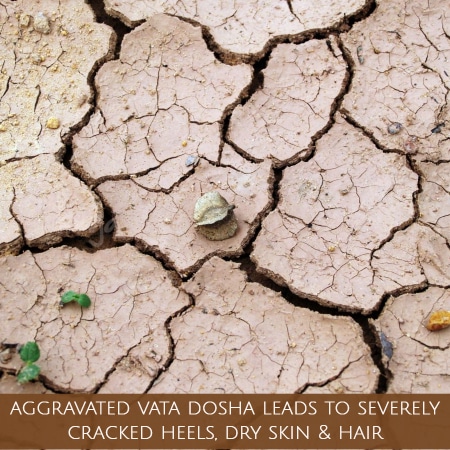This post was last updated on February 21, 2023 by srinivas krishnaswamy
Ayurveda places great emphasis on habits to balance vata dosha. Aggravated vata dosha is a common root cause of many conditions like dry skin and dry hair , difficult bowel movements, constipation and scanty periods.
If you are frustrated with dry hair and skin, then you need to understand how to balance vata dosha. This knowledge will really help you in your overall journey to great health
If you are absolutely new to Ayurveda & wondering what is vata-dosha , read this post. Or you could continue here be reading this actual Krya customer case study to understand the effects of aggravated vata-dosha on your skin and hair
Vata HairFall – A Krya case study
We received a product consultation request from a 36 year Krya consumer , who was experiencing very high hair fall and hair dryness. From our investigation, we found 3 important signs of high vata -aggravation
- She found it difficult to fall asleep despite being very tired. In her email she said: “I toss and turn at night for nearly an hour before I fall asleep”.
- She described her bowel movements as being sluggish and incomplete. The bowel movements felt hard , compacted and were difficult to pass out
- She described her periods as being scanty and variable in their nature – so her menstrual cycles varied from 29 days to 36 days every month. Within the variation , the blood flow was less, and the period was usually accompanied by cramping (both being clear signs of aggravated vata dosha
Ayurveda treats the underlying root cause of all problems like dry hair & dry skin. So when the customer came to us for recommendations for dry skin & dry hair, we are able to confirm the root cause by asking other questions like those mentioned above. So in order to help her with dry skin & dry hair, we recommended Krya products along with other lifestyle modifications to balance vata dosha. In the rest of this post we will dive deep into the nature of vata dosha, how we aggravate it & what are the solutions from Ayurveda
The Nature of vata dosha and its role in the body
Vata is the most powerful dosha in our body – it governs the action of the other 2 doshas in our body as neither have mobility without vata. The 3 doshas in our body are in turn made up of the pancha bhootas or the 5 basic elements – and vata is made up of air (vayu) + space(akash). This gives Vata dosha the quality of movement, lightness, swiftness and speed.

All of us are made up of a mixture of the 3 doshas ( vata, pitta & kapha) & the sum of the three doshas always stays constant at 100% . So when we say vata-dosha is aggravated, this means that is has increased in proportion in our body from say 35% to 45% – this automatically means that another dosha(s) must have decreased due to the 10% points increase in vata dosha.
At birth , our prakriti (natural sate) is determined by a combination of the theree doshas in different proportions. Naturally, for each of us, one or two doshas show pre-dominance making up our general character and determining our attitudes, behavior in situations and the kind of illnesses we are prone to. Apart from our basic dosha nature, the doshas in our body can increase or decrease depending upon what we eat, how we behave and how the environment around us changes and of course with ageing.
Vata dosha is of course present in ALL of us. It performs extremely critical functions in our body and also helps transport the other 2 doshas (pitta & kapha) within the body, thus playing a role in their functions as well.
Balancing Vata dosha & the perils of Urban life
Acharya Charaka, one of the two principal ancient sages to have compiled Ayurvedic texts, says that 50% of diseases occur due to aggravation of vata dosha. So understanding this concept is really useful for us in managing our health better.
Vata aggravation is extremely high in city dwellers. The very design of city life – with high rise apartments, long commutes to work, stressful jobs very high usage of air-conditioning in offices , homes, malls , late-nights & frenetic pace of living – are all potent causes of vata-aggravation. This is a very important concept to understand in our quest to balance vata dosha naturally

Let us understand this concept in some more detail. Take the reality of long commutes to work that many of us struggle with today. A long commute, especially with the a/c switched on, increases the movement, wind & cold exposure. Vata-dosha’s nature is cold , dry, rough & mobile. Naturally such cold, long commutes daily aggravate vata-dosha in our bodies.
City dwellers also may work late, and fuel themselves with fried and stimulating food and drinks. Urban India , in general, has taken to large amounts of potatoes, maida, fried and baked goods, broiler chicken, cauliflower, etc which are all vata aggravating. Many of us also drink large amounts of tea and coffee. All these factors contribute to aggravation of vata dosha, which we need to balance, for good health

Where does Vata aggravation show up in our body?
First we need to understand a very subtle concept, i.e the natural seat or location for each dosha. Vata dosha is naturally supposed to be present in the lower part of the body ( below navel) , in the skin , the ears & the bones. It is vital to remember this concept to understand how to balance aggravated vata-dosha & also why techniques like Abhyanga snana are so effective
The other concept to know is the function of Vata dosha . All mobility and downward movements in the body are governed by vata dosha
So Vata governs all downward movement including the expulsion of urine, feces and menstrual discharge. If your stools are hard and dry, and bowel movement is not smooth and easy, Vata dosha is aggravated and needs to be brought under control. Similarly if you have scanty periods where timing is uncertain and there is a lot of variability in the cycle, your body is aggravated with too much Vata dosha. Aggravated vata dosha also results in painful cramps during the menstrual cycle, cycle variability, etc. Bringing vata dosha under control can greatly improve your menstrual experience
The bones are also a seat of vata-dosha .If your back feels stiff, your knees crack or pop, or if your wrists tingle or hurt from excessively using your smartphone, then Vata has been over used and needs to be controlled.

We have already seen that the skin is a natural seat of Vata dosha. So when Vata is aggravated, it also shows up in the state of our hair, nails, skin and feet. Excessively cracked heels which do not respond to any form of moisturization can be attributed to aggravated Vata dosha. Similarly chronically dry skin and hair can also be a result of vata aggravation. People who lose weight very quickly or find it very difficult to gain weight may also be naturally high in vata dosha. In all these cases, when vata dosha is brought under control, there is noticeable improvement in the symptoms. This approach works much better than trying to work on the symptoms alone.

Vata aggravated people also find it difficult to get high quality , restful sleep. They either find it difficult to fall asleep, or do not stay in deep sleep for long – so they wake up feeling fatigued, run down and low on energy. This makes them choose stimulants like tea and coffee which are again high in Vata dosha, starting a vicious cycle.
Again here, as discussed above, when vata dosha is balanced, the symptoms of vata aggravation are improved. So merely taking a sleeping tablet will not help vata-related insomnia. Identifying and addressing the vata aggravation and working on controlling it will help better.
Modify Lifestyle habits to balance Vata dosha
Not everyone’s constitution is fundamentally high in Vata dosha. Yet, we CONSTANTLY see symptoms of aggravated Vata across the world today. This is driven both by the nature of urban life ( as discussed above) and our modern lifestyle habits, which are very vata-aggravating
- Agitation aggravates Vata dosha. Since the basic nature of vata is mobility like the wind (vayu) , excessive agitation by long calls on the cell phone, over stimulation due to social media consumption all cause Vata-aggravation
- Similarly chaos is the nature of Vata – so in contrast, order & rhythm are factors that balance vata dosha. If we have a chaotic schedule with no proper set times to sleep, eat & work, then we aggravate vata dosha
- Late nights have a rooksha ( drying ) effect on our body. And another core property of vata-dosha is dryness. So if late nights ( beyond 10 PM) are a part of our lifestyle, then we become prone to vata-aggravation. Worse still, most of us consume a lot of social media at night, which is even more aggravating
- Eating foods which are high in Vata dosha. Deep fried, hard , dry & crisp foods are all vata-aggravating. Examples are Ready to eat Noodles, Instant foods, Breads, breakfast cereal and vegetables like potatoes and cauliflower and snacks which consume a lot of oil. In times of stress, people tend to consume these foods preferentially over others. This in turn severely aggravates Vata dosha.
- Excessive talking and excessive media consumption via social media, Whatsapp and Smartphone usage

.

How to heal the root cause of dry skin & hair
To summarize the many fundamental properties of vata-dosha already described above – Vata dosha is “rooksha” (dry), “laghu” (light) “Sheetya” (cold) , “vishada” (non slimy), “khara”(coarse) and “Daruna” (instable).
Therefore, it is NO WONDER, that when Vata is aggravated, the very same symptoms are manifested at the level of the skin and the hair. Dry skin, cracked lips, dry frizzy hair, split ends are all signs that your vata-dosha is aggravated and un-checked in those areas.
So to reverse this condition of dryness, we have to BALANCE Vata dosha from its current abnormally high level in the body.
How do we do that?
5 point program to balance aggravated Vata dosha and improve dry skin and hair
1. Regular Oil Massage all over the body, especially in the primary vata seats (ears, abdomen, wrists, knees, joints & scalp ). In Ayurveda, this daily head-to-toe self oil-massage is known as Abhyanga-Snana and it it is very important Dinacharya ( daily habit). As described above vata by nature is cold, dry & rough – therefore to balance vata , oil massage is highly effective as the oil is warm & unctuous and combined with the physical act of “touch” it balance .
For those with very high vata-dosha aggravation, daily Abhyanaga Snana is beneficial. In normal course of life, regular Abhyanga once or twice a week will give excellent health benefits for all of us. Tuesdays/Fridays are ideal Abhyanga days for women and Wednesdays/Saturdays are the recommended days for Men. To understand this day of the schedule concept better, you can read this detailed blog post
2. Apply oil FREQUENTLY and REGULARLY on dry skin & hair – As we have seen in #1 above, oil application is a vital tool in balancing vata-dosha. If you have very dry hair, you should use apply an Ayurvedic hair oil on your scalp at least 4-5 times a week. Like with oil application on the body, shiro-abhyanga is also recommended daily in the texts as a dinacharya habit. Regular hair Oil application on the scalp balance scattered vata dosha, nourish hair from the roots and help proper, re-generative hair growth. Like-wise for very dry skin, apart from the Abhyanga Snana oil application on skin, we can recommend using the Krya Palamrosa skin oil, for post-bath leave-on application on the dry areas.
3. REGULATE your exposure to cold and dry winds. As we saw above, the nature of vata is cold, dry & rough . So strong wind, cold air, long distance travel in a/c cars and office air conditioning all aggravate Vata-dosha. To control this impact, plug your ears and cover the head while travelling. Keep your body warm in cold temperatures by wearing layers of clothing and additional garments like a shawl for warmth. Layering of clothing is an extremely practical and effective way of controlling vata-doha, whether in a/c offices or car commutes.
4. CUT DOWN on your use of electronic media, especially post 8 pm. Agitation excites vata-dosha. So the excess use of electronic screens & constant scrolling of social media feeds aggaravate vata dosa.To balance this, cut down on your use of phones/social media & preferably switch off from the internet one/two hours before bedtime. Aggravated vata-dosha interferes with sound sleep.
5. MONITOR your diet – In times of stress, all of us gravitate towards vata-aggravating food (pizzas, burgers, fries, cola, caffeine, deep-fried foods etc). The more such foods are consumed, the more they throw our doshas out of balance and the more dry our hair and skin get. Read this post for a detailed note on how to choose right foods to help balance vata dosha


To sum up:
All skin and hair issues are indicative of a deeper underlying dosha imbalance. Ayurveda, therefore treats them at the root cause level. So even dry skin and dry hair are analyzed for what they truly represent: aggravated or imbalanced vata.
Skin and hair systems are not just important for aesthetic reasons. They are our early warning systems through which our body communicates with us and lets us know of underlying problems.
Chronically dry skin and dry hair point to deeply aggravated vata . Vata dosha is a critical dosha in our prakriti which governs many important functions. As it is the only dosha capable of movement, it also does the job of transporting the other 2 doshas where they are supposed to be. So when Vata is aggravated the functions of the other 2 doshas are also impaired.
City living easily and quickly aggravates Vata dosha. This post explored different aspects of how we can balance aggravated Vata dosha in simple yet effective ways.
If you have any questions on aggravated vata , or would like us to recommend Krya products , please write to us at goodies(at)krya.in (or) click here to chat on WhatsApp
Krya products to help balance Vata-Dosha
- Krya Abhyanga Skin Oil :A traditionally formulated ayurvedic abhyanga oil designed to balance all 3 doshas. Can be used by all adults for regular weekly Abhyanga Snana
- Krya Intense Abhyanga Oil – Specially formulated to help balance severe vata aggravation, like in the case of post-partum mothers, athletes, elderly people with joint pains etc

- Krya Women’s Ubtan and Men’s Ubtan : to completely cleanse skin and remove excess oil after an Abhyanga without drying, dehydrating or damaging Srotas of the Skin
- Krya Moisture Plus Skin system (consists of Krya Moisture Plus skin Oil, Moisture plus face mask and Moisture plus Face wash) to help chronically dry skin

- Krya Conditioning hair system (consists of Krya Conditioning hair Oil, Conditioning hair mask, & Conditioning hair wash) for severely dry hair

- Krya Harmony hair oil for stress related chronic scalp dryness
If you found this post useful , here is another fascinating case study of a Krya customer , who shares her Ayurvedic journey from vata imbalance to Harmony




Hi..I am.having dry hair. But no other symptom. Have put on lot of weight. Am hungry all the time. In spite of exercises I am unable to lose weight. Period is irregular. Please help
Priya: have you consulted a vaidya on this?
Iam a vata prakriti person.. Having hairs on body… And little bit facial hairs.. And also having pimples problem…. And also my weight is not increasing.. So plz guide me… And plz tell me to what to do….
Sonali,
As we are an external products company, we do not guide on internal problems. For skin / hair issues, please write to us – [email protected]
Is using a blow dryer to dry the hair increasing vata dosha?
Hello, yes it does.